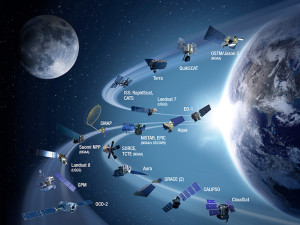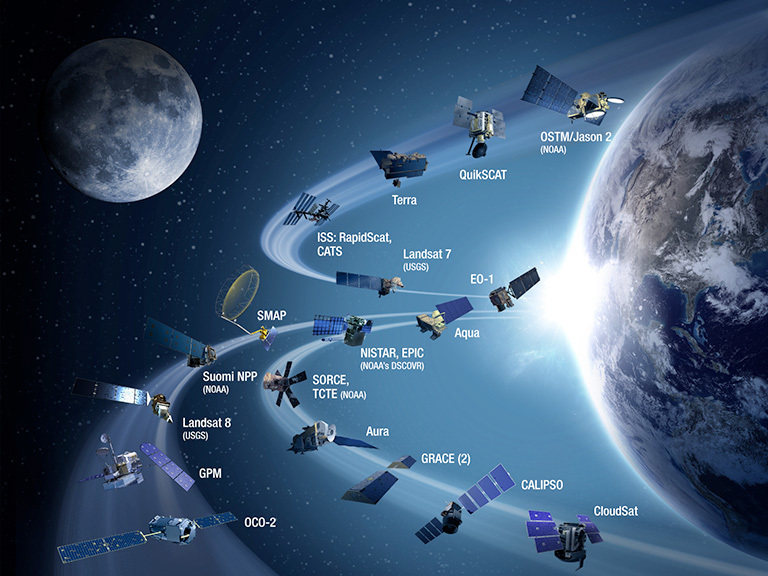NASA conducts a program of breakthrough research on climate science, enhancing the ability of the international scientific community to advance global integrated Earth system science using space-based observations.
The agency’s research encompasses solar activity, sea level rise, the temperature of the atmosphere and the oceans, the state of the ozone layer, air pollution, and changes in sea ice and land ice. NASA scientists regularly appear in the mainstream press as climate experts. So how did the space agency end up taking such a big role in climate science?

When NASA was first created by the National Aeronautics and Space Act of 1958, it was given the role of developing technology for “space observations,” but it wasn’t given a role in Earth science. The agency’s leaders embedded the technology effort in an Earth Observations program centered at the new Goddard Space Flight Center in Greenbelt, Maryland, in the U.S.. It was an “Applications” program, in NASA-speak. Other agencies of the federal government were responsible for carrying out Earth science research: the Weather Bureau (now the National Oceanic and Atmospheric Administration or NOAA) and the U.S. Geological Survey (USGS). The Applications program signed cooperative agreements with these other agencies that obligated NASA to develop observational technology while NOAA and the USGS carried out the scientific research. The Nimbus series of experimental weather satellites and the Landsat series of land resources satellites were the result of the Applications program.
This Applications model of cross-agency research failed during the 1970s, though, due to the bad economy and an extended period of high inflation. Congress responded by cutting the budgets of all three agencies, leaving NOAA and the USGS unable to fund their part of the arrangement and putting pressure on NASA, too. At the same time, congressional leaders wanted to see NASA doing more research toward “national needs.” These needs included things like energy efficiency, pollution, ozone depletion and climate change. In 1976, Congress revised the Space Act to give NASA authority to carry out stratospheric ozone research, formalizing the agency’s movement into the Earth sciences.
NASA’s planetary program had a lot to do with scientific and congressional interest in expanding the agency’s role in Earth science. The Jet Propulsion Laboratory, NASA’s lead center for planetary science, sent Mariner series probes to Venus and Mars. Astronomers considered these to be the “Earth-like” planets in the solar system, most likely to have surface conditions able to support life.
But that’s not what they found. Venus had been roasted by a super-charged greenhouse effect. In contrast to Earth, Venus had about 300 times more carbon dioxide in its atmosphere, no significant water vapor and a surface temperature hotter than molten lead. Mars, on the other hand, had an atmospheric pressure about 1 percent of that of planet Earth and temperatures far below freezing. Pictures showed no surface water – it would have been frozen anyway – but they also seemed to show that it once had liquid water.
These discoveries left planetary scientists with unanswered questions. How did Earth, Venus and Mars wind up so radically different from similar origins? How could Mars have once been warm enough to be wet, but be frozen solid now? These questions revolve around climate and the intersection of climate, atmospheric chemistry and, on Earth, life.
Moving back to Earth
But just as planetary scientists began confronting these questions, Congress lost interest in planetary exploration. NASA’s planetary exploration budget sank dramatically starting in 1977, and the Reagan administration threatened to terminate planetary exploration entirely. This was partly due to high inflation in the U.S., and partly due to the agency’s focus on the space shuttle, which could only reach low Earth orbit. The shuttle focused agency leaders’ attention on studying the Earth from orbit, not on the other planets
he same decade had witnessed a revolution in scientists’ understanding of Earth’s climate. Prior to the mid 1960s, geoscientists believed that our climate could only change relatively slowly, on timescales of thousands of years or longer. But evidence from ice and sediment cores showed that belief was wrong. Earth’s climate had changed rapidly in the past—in some cases, within mere decades. Recognition that climate could change on human timescales made climate processes much more interesting research topics. It also spurred political interest.
It had been known since 1960 that humans were increasing the amount of heat-trapping greenhouse gases in the atmosphere. Would this warm the climate noticeably? Scientists also knew that human emissions of aerosols could cool the Earth. Which effect would dominate? A 1975 study by the U.S. National Academy of Science said, in effect, “We don’t know. Give us money for research.” A 1979 study of carbon dioxide’s role in the climate put it slightly differently. They had found “no reason to doubt that climate changes will result and no reason to believe that these changes will be negligible.”
Declining planetary funding and growing scientific interest in the Earth’s climate caused planetary scientists to start studying the Earth. It was closer, and much less expensive, to do research on. And NASA followed suit, starting to plan for an Earth observing system aimed at questions of “global change.” This phrase included climate change as well as changes in land use, ocean productivity and pollution. But the Earth science program that it established was modeled on NASA’s space and planetary science programs, not the old Applications program. NASA developed the technology and funded the science. In 1984, Congress again revised the Space Act, broadening NASA’s Earth science authority from the stratosphere to “the expansion of human knowledge of the Earth.”
In the early 1980s, NASA began working on an expansive Earth science program plan called Global Habitability, and that eventually became the Mission to Planet Earth. At the same time, a multi-agency effort called the Global Change Research Program was also taking form. NASA’s role in that larger U.S. program was the provision of global data from space. Approved in the fiscal year 1991 budget, the resulting Earth Observing System would be the agency’s primary contribution to American climate science.
The Earth Observing System era
Fast forward to 2007, and NASA had 17 space missions collecting climate data. Today, it runs programs to obtain and convert data from Defense Department and NOAA satellites as well as from certain European, Japanese and Russian satellites. NASA also sponsors field experiments to provide “ground truth” data to check space instrument performance and to develop new measurement techniques.
Instruments on NASA’s Terra and Aqua satellites have provided the first global measurements of aerosols in our atmosphere, which come from natural sources such as volcanoes, dust storms and man-made sources such as the burning of fossil fuels. Other instruments onboard the Aura satellite study the processes that regulate the abundance of ozone in the atmosphere. Data from the GRACE and ICESat missions and from spaceborne radar show unexpectedly rapid changes in the Earth’s great ice sheets, while the OSTM/Jason-2 and Jason-1 missions have recorded an increasing rate of sea level rise. NASA’s Earth Observing System’s weather instruments have enabled the first improvement in weather forecasting skill in more than a decade.
These capabilities — nearly 30 years of satellite-based solar and atmospheric temperature data — helped the Intergovernmental Panel on Climate Change come to the conclusion in 2007 that “Most of the observed increase in global average temperatures since the mid-20th century isvery likely due to the observed increase in anthropogenic greenhouse gas concentrations.” But there’s still a lot to learn about what the consequences will be. How much warmer will it get? How will sea level rise progress? What will happen to soil moisture, and therefore agricultural production, in a warmer world? NASA scientists and engineers will help answer these and other critical questions in the future.








